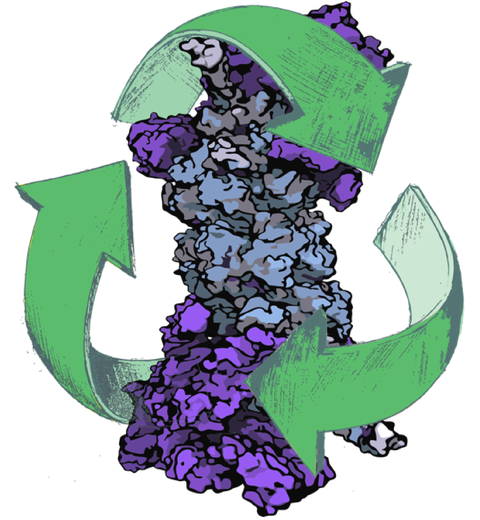Highlights of our Work
2025 | 2024 | 2023 | 2022 | 2021 | 2020 | 2019 | 2018 | 2017 | 2016 | 2015 | 2014 | 2013 | 2012 | 2011 | 2010 | 2009 | 2008 | 2007 | 2006 | 2005 | 2004 | 2003 | 2002 | 2001
While waste recycling in daily life has become popular only recently,
living cells have been recycling their protein content since
the very beginning. Recycling of unneeded protein molecules in cells
is performed by a molecular machine called the proteasome, which cuts these
proteins into smaller pieces for reuse as building blocks for new proteins.
Proteins that need to be recycled are labeled by tags made of poly-ubiquitin
protein chains. The proteasome machine recognizes and binds to these tags,
pulls the tagged protein close, then unwinds it, and finally cuts it into
pieces. Despite its substantial role in the cell's life cycle, the
proteasome's atomic structure and function still remain elusive. In our
recent
study,
we obtained an atomic structure of the human 26S proteasome by combining
computational modeling techniques,
through molecular dynamics flexible fitting (MDFF) of the cryo-electron microscopy (cryo-EM) data.
The features observed in the resulting structure are important for coordinating
the proteasomal subunits during protein recycling.
One of the key advances is that for the first time the nucleotides
bound to the ATPase motor of the proteasome are resolved.
The atomic resolution of the structure
permits to perform molecular dynamics simulations to investigate the detailed proteasomal function,
in particular the protein unwinding process of the ATPase motor.
Furthermore, our obtained structure will serve as a
starting point for structure-guided drug discovery,
developing the proteasome as a crucial drug target.
The atomic models are deposited in the protein
data bank (PDB) with the PDB IDs 5L4G and 5L4K and the 3.9 Å resolution
cryo-EM density is deposited in the electron microscopy data bank
EMD-4002.
More information about our proteasome projects is available on our
proteasome website. Easy access to our modeling techniques is provided through
QwikMD, which was employed here for the first time.




